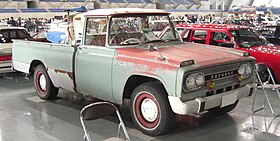Toyota Stout
| RK | |
|---|---|
 |
|
| Overview | |
| Manufacturer | Toyota |
| Production | 1954-1960 |
| Assembly | Honsha Plant, Toyota City, Aichi, Japan |
| Body and chassis | |
| Class | light truck |
| Layout | FR layout |
| Platform | ladder frame |
| Related | |
| Powertrain | |
| Engine | 1.5 L R I4 |
| Dimensions | |
| Wheelbase | 2,500 mm (98.4 in) |
| Length | 4,265 mm (167.9 in) |
| Width | 1,675 mm (65.9 in) |
| Height | 1,735 mm (68.3 in) |
| Curb weight | 860 kg (1,896 lb) |
| Chronology | |
| Predecessor | Toyota SG |
| Successor | RK45,100,101 |
| RK40, RK41, RK43, RK45, RK47, RK100, RK101 | |
|---|---|

A Stout in unrestored condition at a 2009 car show
|
|
| Overview | |
| Manufacturer | Toyota |
| Also called |
|
| Production | 1960-1978 |
| Assembly |
|
| Body and chassis | |
| Class | light truck |
| Body style | Pickup |
| Layout | Front-engine, rear-wheel drive |
| Related | Toyota Dyna |
| Powertrain | |
| Engine | |
| Transmission | 4-speed manual |
| Dimensions | |
| Wheelbase | 2,600–2,800 mm (102.4–110.2 in) |
| Length | 4,286–4,690 mm (168.7–184.6 in) |
| Width | 1,690 mm (66.5 in) |
| Height | 1,750 mm (68.9 in) |
| Curb weight | 1,420 kg (3,131 lb) |
| Chronology | |
| Predecessor | RK30/35 |
| Successor |
|
| RK110, RK111, YK110 | |
|---|---|

A 1981 model in Chile
|
|
| Overview | |
| Manufacturer | Toyota |
| Production | 1979-1989 |
| Assembly |
|
| Body and chassis | |
| Class | light truck |
| Body style | pickup |
| Layout | front-engine, rear-wheel drive |
| Platform | ladder frame |
| Related | Toyota Hilux |
| Powertrain | |
| Engine | |
| Chronology | |
| Predecessor | Stout RK101 |
The Toyota Stout was a light truck produced by the Japanese automaker Toyota from 1954 through 1989. The Stout shared its platform with the Toyota Dyna until 1968, when the Dyna was given its own platform, called the Toyota "U". In Japan, it was sold at Toyota Japanese dealerships called Toyopet Store.
Introduced in April 1954 as the Toyopet RK 1¼ ton truck, it was larger than the similar Toyota SG light truck but smaller than the Toyota FA medium duty truck. In 1955 it was upgraded to carry 1.5 tons.
The standard body was a 2-door, 3 seater pickup with a separate well body (with a fold down tailgate). Other bodies advertised by Toyota included a van, an ambulance, double cab coupe utility (2-doors, 6 seater, integral well body), drop-side pickup, pickup with stake sides, a pickup with full height metal side with a canvas top, a light bus (precursor to the Coaster) and an ice cream van.
All models used mechanicals common to new vehicles of its time, such as a ladder frame chassis, leaf springs, solid axles and 4 wheel drum brakes. The engine was the 48HP 1500 cc Type R with a manual transmission. The body was professionally finished with windscreen wipers, dual outside mirrors (1955 onwards), hubcaps, chrome trim and dual headlights.
The 1954 model was designated as a 1¼ ton truck but was actually rated to carry 1220 kg. The 1955 model was designated as a 1.5 ton truck but was actually rated to carry 1330 kg.
In 1957 the RK was revised to become the RK30 and the RK35. In May 1959 it was named the Stout. Its main competitor was the Nissan Junior.
Completely redesigned in 1960, this is the most familiar version of the Stout. The Japanese market had the 1,453 cc Type R engine in the RK45 and the 1,897 cc 3R-B engine in the RK100, which was introduced in October 1962. Along with the new optional engine, the Stout also underwent a facelift, including twin headlights. In September 1963 there also appeared a shorter and lighter duty (type RK40) model called "Light Stout", which featured independent coil sprung front suspension for a more carlike ride. This was meant to compete directly with Nissan's Datsun minitrucks, but it never sold particularly well in its home market and was replaced by the Briska and Hilux following Toyota's takeover of Hino Motors.
...
Wikipedia
